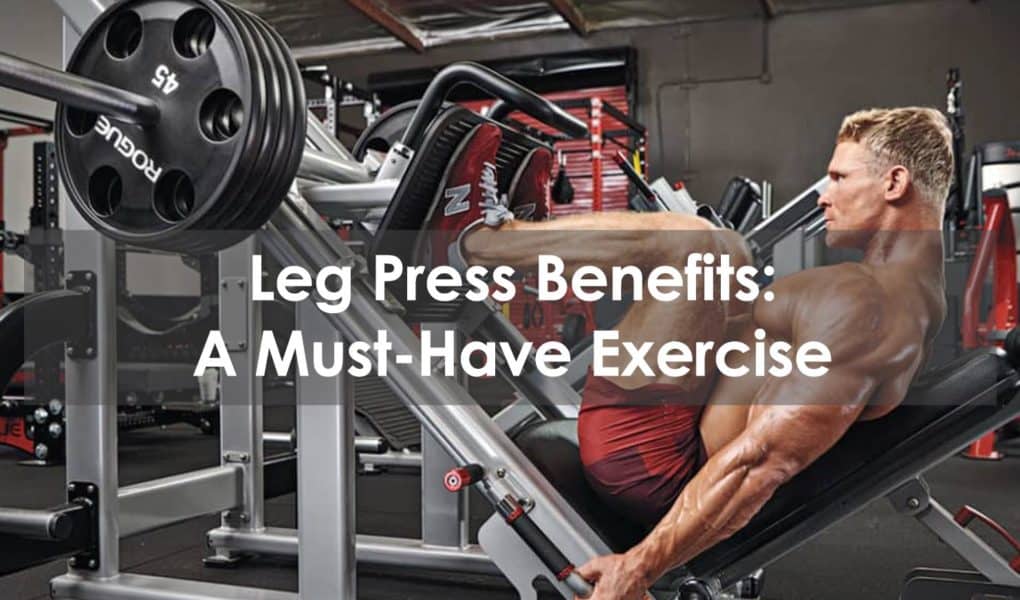Squats, lunges, and deadlifts are often touted as the go-to leg exercises. But what most beginners don’t realize is that these exercises, especially when loaded up with a barbell, are very advanced movements, and have a high potential for injury.
While these fundamental lifts are foundational to functional strength, there are many machines that can provide similar benefits, while having the added advantage of safety and control. Leg press machines, in their various forms, are one such way to improve the functional strength of the lower body.
This article will provide a useful overview of this exercise, listing all the great benefits that come with it. We’ll cover the different types of machines that you can use, all the major muscles that are stimulated, how to correctly set up and perform the exercise, and the many variations you can add to your program.
We’ll also answer some of the most common questions gym-goers ask when looking at getting started with the leg press.
What is the leg press?
The leg press is a lower body strength exercise. Leg presses benefit all the major muscle groups of the lower body, using external weight to provide resistance to the muscles. There are a couple of different variations of the leg press machine.
The first is the seated leg press. This workout station is usually a pin-loaded machine with a horizontal slide, a padded reclined seat, and a stance plate.
The 45-degree leg press is a plate-loaded machine that uses gravity to provide resistance to the leg muscles. Leg press machines allow you to train your lower body through a large range of motion.
Leg presses are a great alternative to other popular compound leg exercises, like squats, because they assist with balance and safety. They also allow you to more easily work on your form with the assistance of the machine.
Benefit #1: Quadriceps killer
One of the major movements in the leg press exercise is knee flexion. This is one of the primary actions of the quadriceps. The quadriceps are the four large muscles on the front of the thigh, including the rectus femoris and vastus intermedius, lateralis, and medius. The leg press is also easily adjustable to place more emphasis on quad strength while keeping the knees safe.
Benefit #2: Hamstring helper
The hamstrings work to eccentrically lower the weight in the leg press, flexing the knees under tension. They also contribute to the hip extension as you press the weight up. In fact, the unity of the hamstrings with the other lower body muscles gives leg presses considerable functional strength capacity.
Benefit #3: Glute grower
As the major hip extensor muscles, the glutes get some work in during the leg press, although exercises like squats and bridges provide better positions for hip extension. That being said, the leg press does provide a stretch under tension for the glutes that many exercises don’t.
Benefit #4: Balance builder
The large inner thigh muscles are at risk of injury for many trainees and athletes. Leg presses allow you to work on controlling the position of your joints as you go through a full range of motion, helping strengthen these muscles and create better overall leg development and muscle mass.
These are muscles that help keep your lower body joints in alignment, which is essential for balance and direction-change in sports.
Benefit #5: Calf carver
The often neglected calf muscles are essential for many functional movements – like walking, for example! But they also need to be trained for strength and power in order to run and jump, and modified calf raises on the leg press machine is a great way to achieve this.
Benefit #6: Core control
While the upper body is not as involved in the performance of a leg press as it is in something like a barbell squat, the core muscles still need to work hard to brace the trunk as the lower body is loaded up. The gluteal muscles support the outside of the pelvic area, but it’s the deeper muscles of the core and pelvic floor that keep everything compressed and stable.
Strong glutes, quads, hamstrings, and calves aren’t the only leg press benefits. This is also a safe and effective exercise to build stronger bones in the lower body. With progressive overload, leaving the squat rack to jump on the leg press machine can also increase your explosive strength and explosive power, increasing your sprint speed and vertical jump height.
How to perform the leg press
Setup
The leg press machine is a large, heavy, and complex piece of equipment. As mentioned, the machine will use either weight plates or a pulley-controlled weight stack as resistance. Your body weight won’t affect the weights you need to load, as is the case for standing leg exercises.
Carefully adjust the seat incline, safety bar level, and weight load appropriately before beginning your set.
Each gym may have a slightly different version of the machine. If you’re not sure of anything, don’t hesitate to approach the gym staff to assist you in setting up the machine, and observing you for a set or two to correct any issues.
Technique
The starting position in a standard leg press workout involves assuming a straight seated position with your back against the padded backrest. The standard foot position is a shoulder-width stance, with the feet flat and shins parallel to eye-level.
On a 45-degree machine, you’ll need to engage the platform a little to release the safety catch. Turn the handles out, then hold on to the handgrips.
Keeping your lower back on the bench, begin the control phase, lowering the heavy weights as you bend your knees and hips towards you. With proper form, lower to around 90 degrees of knee flexion (less if you are recovering from a knee injury).
If appropriate, conduct a holding phase at the bottom of the movement, then use your leg strength to press back to the top.
Repeat for the required repetitions, then replace the safety catch before releasing the plate. Sometimes it can be a good idea to get up and walk around a little as you rest between sets, to avoid cramping up in the legs.
Common mistakes
Leg workouts often involve heavier weights, so there can be more risk of injury. Lower body exercises are also complex, with lots of variations, and muscles working together.
The two most common mistakes in leg presses are rolling the hips back at the bottom of the movement, letting the lower back come off the pad and putting pressure on the spine; and locking the knees out at the top of the lift, which puts a lot of stress through the knee joints.
Again, it’s worth seeking help when first trying the leg press. It’s better to get the technique right early on than create problems with poor form as you increase the intensity.
Bonus benefit: Leg press variations
Wide stance: The biggest benefit of this variation is the added range of motion for the hamstrings. Some trainees can even lift larger amounts of weight with a wider stance on their platform. Be sure to engage the outer thigh muscles to keep the knees tracking over the ankles.
Narrow stance: While not one of the most common or functional exercises on the leg press machine, this version focuses on the inner thigh area, particularly the medial quadriceps muscle and the adductors. A good supplementary exercise for this is the leg extension.
High stance: This exercise can be easier on the weight stack machines rather than the 45-degree leg press, as it’s easier to keep the back flat in the push-off and lifting phase. This move creates more stretch for the hamstrings and takes some pressure off the knees.
Low stance: If you want to focus on the physical performance of your anterior thigh muscle development, try placing the feet a little lower. This will make the stronger quadriceps the primary leg press muscles during this strength training variation, making it one of the best knee flexion exercises to include in your leg day workout.
Single leg: The single-leg press requires a lot of control and core strength as you keep everything aligned. With the correct form, this is one of the best balance recovery tasks, if lack of balance is one of the activities you want to improve for life or sport.
Calf raise: There are other types of movements you can perform on the leg press machine, including using it as a calf raise machine. The platform is a great way to load up for the strength work portion of your calf routine, giving a great stretch to the ankle joints for depth in the movement.
To perform the leg press calf raise variation, place the balls of the feet on the bottom of the platform, with the heels hanging off the edge. Unlock the safety catch, and let your calves stretch before pushing and pointing your toes. Be sure not to lock out the knees.
Conclusion
While there are many kinds of leg exercises that are effective, the leg press exercise is one of the best weight machines for the lower body. Seated leg press benefits are numerous, and at least a couple of these weight lifting exercises should be part of any weight training routine.
So start with a relatively light weight, practice your setup and exercise technique, and gradually progress with your leg presses while supporting them with accessory exercises. You’ll be the star of the next viral leg press video in no time!
Frequently Asked Questions
Do leg presses help improve your squat?
Yes! The leg press allows you to strengthen all the muscles and joints of your lower body. The main difference with a squat is that the hips reach a greater range of extension, and the spine deals with a lot more load (if they are standard squats like bar squats).
The leg press machine allows you to lift huge weights, without putting strain on your back or risking dropping the weight on yourself. If any particular muscle is lacking and affecting your squat, you can use the variations of the leg press to strengthen them and correct any muscle imbalance.
One warning would be not to transition from very heavy leg pressing straight into very heavy squatting. This is because the supporting muscles that control position and balance don’t need to work as hard in the leg press, and the back and upper body are largely supported by the seat. These areas will need to be trained up as well, which is why it’s best to do both leg presses and squats as part of your workout plan.
Is leg press better for your knees than squats?
If done in the correct positions, the leg press can be safer and more controlled for your knees. There is less tension on the knee than in exercises like the knee extension, too. Using exercise equipment like the leg press makes the hip, knee, and ankle motion a more simple movement, without needing the extra skill and concentration required by squats.
That being said, even if your knees aren’t the best, squat variations and leg press can both be crucial parts of your workout routine. You can train smart, achieve well-defined glutes, strong quadriceps, and achieve amazing leg power and athletic performance.
If you have a serious knee injury or pain, be sure to consult with an accredited exercise professional. They will be able to program your leg press movements to suit your situation.
Does the leg press make your butt and thighs bigger?
Not necessarily. The leg press certainly has the potential to increase the muscle mass in your lower body – but only if that’s what you want. If you are training for weight loss, you can train with lighter weights and higher rep ranges, and train for endurance rather than focusing on weight progression.
You can even focus on strength development, with heavy weights and low reps. This way you’ll tone and firm up the primary muscles in your legs without increasing their size because the real benefit will be for the nervous system.
It is important to note that hip and thigh circumference is largely dependent on your diet, so be sure to get your eating on point to reduce your body measurements.







